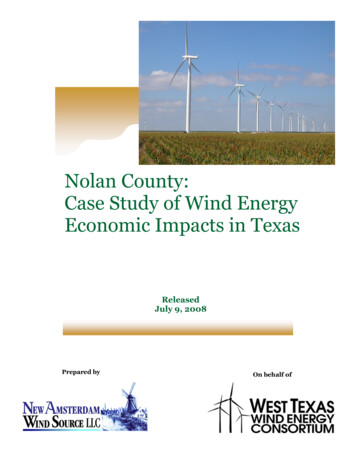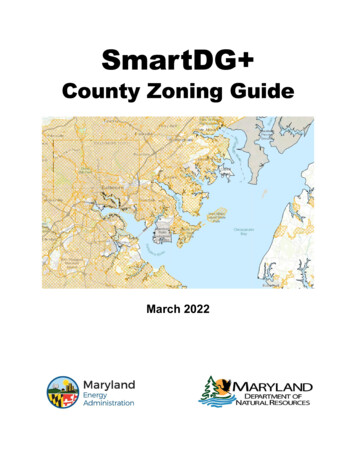
Transcription
Nolan County:Case Study of Wind EnergyEconomic Impacts in TexasReleasedJuly 9, 2008Prepared byOn behalf of
Nolan County: Texas Wind Energy Economics Case StudyThe State of the WindWind energy helped to settle vast stretches of Texas, as the traditional water-pumping windmillopened otherwise forbidding territory to settlement and development. Later, “wind chargers” sproutedup on farms and ranchers until widespread rural electrification displaced the first distributed electricitymachines. Utility-scale wind energy turbines arrived in Texas at Fort Davis roughly a century after themilitary fort was retired from its role of protecting westward expansion. In 1994, West Texas Utilities(later AEP) installed 10 turbines between Fort Davis and Valentine in far west Texas.The region also is the site for the oldest continuing utility scale project, the 30 MW DelawareMountains Project and the 35 MW Texas Wind Power Project. McCamey – the Wind Energy Capital ofTexas and a pivotal historic icon in the Permian Basin oil region – took the mantle after 2000 and now ishome to roughly 750 MW, with substantial projects under construction in the greater Fort StocktonMcCamey area.Trent Mesa’s 150 MW wind energy center began operations in Nolan County in 2001, markingthe entry of the Rolling Plains into world-class wind energy operations. By 2006, Texas had passedCalifornia in installed wind energy capacity, and the Lone Star State has not looked back. Both thePublic Utility Commission (PUC) and engineers at the Electric Reliability Council of Texas (ERCOT)project that Texas will have more than 10,000 megawatts (MW) (10 gigawatts, or “GW”) installed by theend of 2008. On a global scale, Texas trails only Germany, the U.S., Spain, India, and China in installedwind energy capacity – placing the Lone Star State as the 6th largest “nation” for wind energy operations.With the anticipated transmission upgrades under consideration by the PUC through the CompetitiveRenewable Energy Zone (CREZ) process, Texas would pass Spain, continue to rival India and China, andwould challenge Germany by 2020.Texas is truly a major global player in the wind energy industry, and the role of Texans goes wellbeyond the deployment of majestic turbines across the vast wind region. In fact, Texas industrialworkers from Brownsville to El Paso, Nacogdoches to Amarillo, Houston to Abilene play a fundamentalpart in the global supply chain of the wind energy industry. Steel and transportation are leading Texasindustries in wind energy, and advanced materials such as carbon fiber are exported from Texas to windenergy companies around the globe. Round Rock is home to the first wind turbine manufacturer inTexas. In a strategic alliance with DeWind, TECO-Westinghouse is manufacturing the DeWind 8.2, a2.0 MW wind turbine. The Texas transportation industry is fully engaged in the wind energy industry –from all of the state’s deepwater ports to its transcontinental railroads, to specialized trucking operationsto hundreds of entrepreneurial pilot car operators.Within the vast Texas wind energy industry sector, Nolan County has emerged as the most activedeployment and operations center for wind energy. The purpose of this study is to detail the economicimpacts of wind energy on Sweetwater and Nolan County, as a method of more precisely projecting thepotential benefits of the industry throughout Texas as the PUC evaluates robust expansion of the Texastransmission grid and the U.S. Department of Energy assesses bold expansion of the U.S. electrictransmission network.Page 2
Nolan County: Texas Wind Energy Economics Case StudyNolan County Case StudyExecutive SummaryHere are some of the findings of our study based on extensive field analysis and interviews:Applying the seven-fold multiplier principle to the primary direct wind energy basepayroll in Nolan County would equate to a 2008 local economic impact of 315,025,200and a 2009 local economic impact of 396,540,380.2008 – 1,124 direct wind jobs, payroll in excess of 45,000,0002009 – 1,330 direct wind jobs, payroll in excess of 56.6 millionLandowner royalties – annual at 2,500 MW installed – 12,264,000, or 17,660,160annually at 3,600 MW installed by late 2009Total taxable property values in Nolan County have increased from 500 million in 1999to 2.4 Billion in 2008 (projected 3.5 Billion by 2010)Cumulative wind energy project property taxes paid in Nolan County (including TrentISD) from 2002 through 2007 30,357,617Nolan County property taxes paid by wind energy projects in 2007 1,724,242Property taxes paid by wind energy projects to Nolan County schools in 2007 12,778,691Cumulative school property taxes paid 2002 through 2007 in Nolan County by windenergy projects (Sweetwater, Blackwell, Trent, and Highland school districts) 22,670,680New school construction in Nolan County school districts (2004 through 2010) 24,000,000Page 3
Nolan County: Texas Wind Energy Economics Case StudyOverviewNolan County in mid 2008 is home to roughly 2,500 MW of operational wind energy, and willexceed 3 GW by early 2009. Together with the adjacent counties of Scurry, Taylor, Mitchell, and Coke,the Sweetwater region is home to well over half of all operational wind energy in Texas andapproximately 15 percent of all U.S. wind energy operations.Nolan County alone has surpassedCalifornia in 2008 in installed wind energycapacity, so that Nolan County would rankas the second largest “state” for windenergy operations. Like the West Texasregion, Nolan County would count asthe world’s sixth largest wind energy“nation” in a current global ranking.Nolan County is home to the largest wind energyprojects in the U.S. and indeed the world. FPLEnergy’s Horse Hollow ranks as the world’s largestwind energy center at 750 MW in Nolan and Taylorcounties. Babcock & Brown’s Sweetwater WindEnergy Center (all within Nolan County) is thesecond largest project in the U.S. at just under 600 MW. AES Wind Generation’s Buffalo Gap Project(Nolan and Taylor counties) is poised to overtake Babcock & Brown’s Sweetwater Wind, as Buffalo Gapphases 4-5-6 come on line in 2008 and 2009. The Buffalo Gap & Sweetwater projects are also beingchallenged by FPL Energy’s Capricorn Ridge-Goat Mountain in adjacent Coke and Sterling counties.Sweetwater, Buffalo Gap, and Capricorn Ridge are all three competing for the title of second largest U.S.wind project, each in the 600 MW range.Looming above all these is the emerging E.on complex of projects in Nolan, Mitchell, and Scurrycounties. Initially developed by Airtricity, the four contiguous projects are centered on the town ofRoscoe in Nolan County and will top out at roughly 1,000 MW – the world’s first 1 GW wind energycenter – in late 2008 or early 2009. The component Roscoe and Champion projects are fullyoperational, while the Inadale and Pyron phases are in the advanced construction stage as of mid 2008.E.on is the largest utility in Germany.Page 4
Nolan County: Texas Wind Energy Economics Case StudyAs Nolan County projects relinquish the titles of “largest in the world” and “largest in the USA”,these titles will be taken over by other regions of Texas, as 3 GW projects have been announced fordiverse areas such as Pampa, Silverton, Laredo, and more. Nolan County is a learning laboratory foreach of the several 3 GW regions that will emerge across Texas as the transmission network becomesmore robust – both within and in addition to the CREZ process. Career opportunities, operationscenters, manufacturing, infrastructure needs, and other demonstrable beneficial impacts of the NolanCounty experience will be seen again and again across the Lone Star State. As McCamey learned fromCalifornia and Sweetwater learned from McCamey, emerging wind centers across Texas will learn fromthe Nolan County model. Community economic development planning will be refined from the NolanCounty model, as larger single projects and longer lead times will enable more sophisticatedcoordination between communities, project owners, and wind construction and operations companies.Nolan County is further useful as a generic economic impact analysis locale because its multipleprojects have evolved over almost a decade with diverse developers bringing the region’s wind energyoperations to fruition across many sets of economic circumstances. Construction of Trent Mesa began in2000, and Nolan County by 2009 will be home to more than 15 wind energy projects controlled by atleast seven different wind energy developers. Even within this broad definition of “owners”, there aremany more ownership group complexities, and some of the largest acquisitions and divestitures in theglobal wind energy industry have involved changes of control in Nolan County wind projects.In addition to Nolan County’s intensity of current operations, the county has more than 1,000MW of new projects under construction for 2008 completion. To put the level of wind projectconstruction in Nolan County into perspective, only the total existing wind operations in each ofTexas, California, Minnesota, Iowa, Washington, and Colorado outrank the wind projects underconstruction in Nolan County. That is, the wind projects under construction in NolanCounty would alone rank as the 7th largest state for wind energy.Data & graphics source: American Wind Energy AssociationNolan County features several types of turbine technology, which also assure that NolanCounty’s experience can be broadly applied, as it is not skewed by exclusive use of any single technology.Nolan County wind projects feature GE Wind 1.5 MW turbines, Siemens 2.3 MW, Mitsubishi 1.0 MW,Vestas 1.8 MW, and DeWind 2.0 MW. The world’s largest commercially deployed turbines – the 3.0MW Vestas V90 on 105-meter towers – stand in adjacent Scurry County.Page 5
Nolan County: Texas Wind Energy Economics Case StudyDeWind has installed its North American 2.0 MW prototype at the Sweetwater Wind EnergyEngineering Technology (SWEET) Center near Highland in Nolan County. The SWEET Center is acooperative enterprise of the City of Sweetwater and Texas State Technical College West Texas. The Cityof Sweetwater provides the land for turbine prototype testing and other energy innovation researchundertaken by TSTC, other academic institutions, and wind energy companies. TSTC owns the DeWindturbine as part of the college’s premier wind energy turbine technology degree and certificate programs.TSTC’s wind turbine technology programs are conducted on and from the college’s Sweetwater campus.Nolan County was formed in 1876 and locally organized in 1881 with the arrival of the Texas &Pacific Railway. Midway between the Atlantic and Pacific oceans, Nolan County’s role as Midway USA issolidified by the intersection of Union Pacific (successor to the T&P) and the Burlington Northern SantaFe (BNSF) railroads, as well as its central point on east-westInterstate 20. The diverse economy is founded ontransportation (rail, trucking, and air), building materialsmanufacturing (gypsum wallboard and Portland cement),agriculture (predominantly cattle and cotton), energy (oil &gas, wind, nuclear, and coal), education, health care,tourism, and retail.Like virtually all of West Texas, Sweetwater andNolan County had seen consistent, significant populationlosses since 1950. High school graduating classes atSweetwater had shrunk from the 200 range in the 1970s to90 in 2005.Population in Nolan County declined 20 percent from 1950 (population 19,808) to 2000(population 15,802). Likewise, Sweetwater’s population declined 16 percent from 13,619 in 1950 to11,415 in the 2000 U.S. Census. Sweetwater’s official population peaked in 1960 at 13,914, and haddeclined by 22 percent to the 2000 Census level.25000Population Decline2000015000100005000Nolan CountySweetwater0200019901980197019601950Page 6The U.S. Census estimated that 21.7percent of Nolan County residents hadincome below the poverty line in 1999(compared to a rate of 15.4 percent for Texasas a whole). Federal estimates indicated that10.7 percent of Nolan County residents hadincomes below 50 percent of the poverty levelin 1999 (compared to a state average of 6.7percent).
Nolan County: Texas Wind Energy Economics Case StudyLandowner royaltiesAt the heart of every wind energy operation in Texas is a private transaction, whereby a privatewind energy developer negotiates a land use agreement with a landowner – in Nolan County, these areprivate family ranchers and farmers for the most part.In Texas, ranchers and farmers are typically paid the higher of (a) an agreed percentage royalty,or (b) a minimum guaranteed payment. Nolan County landowners who have leased their landfor wind energy development receive an estimated 12,264,000 annually in royaltypayments from wind energy operations.This figure is derived from 2500 MW of operational wind energy inNolan County, a 35 percent operational capacity factor, a 40/MWhwholesale energy price, and a four percent royalty. Actual terms ofvirtually all wind energy lease contracts are confidential by theirterms. However, the underlying assumptions used in this equationare reasonable.The wholesale price of 40/MWh is a reasonable mid-range marketprice. Some earlier projects (e.g., pre-2004) may have a lower longterm sales price under their power purchase agreements. On the other hand, a substantial portion ofNolan County wind energy projects are sold into the spot market on a “merchant” basis, often bringingsignificantly higher prices than long-term power purchase agreements.Royalty percentages are negotiated between the wind project developer and the landowner.Earlier lease agreements (e.g., pre-2004) may have royalty percentages lower than four percent, whilemost recent lease agreements have royalty percentages in excess of four percent.A capacity factor of 35 percent is an accepted norm for Rolling Plains wind energy projects.Applying these same underlying assumptions to the current 6,000 MW of windenergy operations in Texas would yield an annual royalty payment stream of 29,433,600 to ranchers, farmers and institutional landowners across Texas. PUC andERCOT officials project 10,000 MW installed in Texas by year-end 2008 – thus yieldingan estimated 50 million to Texas farmers and ranchers. Some transmission expansionscenarios under consideration by the PUC would double the total MW of wind energyinstalled in Texas, making it possible for Texas farmers and ranchers to receive in excessof 100,000,000 annually in wind energy royalties.Given that much of that new wind energy would bein the Texas Panhandle and South Plains (with windcapacity factors approaching 45 percent, ratherthan the 35 percent common in the Rolling Plainsarea), 100 million in annual royalties understatesagricultural income in the most robust PUCscenarios.Page 7
Nolan County: Texas Wind Energy Economics Case StudyDirect employmentTotal employment impactsWind energy jobs are now among the largestemployers in Nolan County. The employment andpayroll totals in this section include only direct windenergy jobs. Ancillary economic impacts and potentialmultiplier effects are presented elsewhere in this study.Within Nolan County’s projected 14,878residents (U.S. Census 2005 estimate), thereare approximately 1,124 direct jobs in the windenergy industry as of mid 2008. Localemployers project that they will have roughly1,330 direct wind energy jobs in 2009.The direct wind energy payroll in Nolan County exceeds 45,000,000 in 2008, andthe 2009 projection based on wind employer interviews will exceed 56,600,000. Thesepayroll totals are conservative. Payroll totals reported in this study take a mid-range wage levelestimated by each employer, assume a straight 40-hour week (despite actual extensive overtime paythroughout the industry), and do not count per diem payments that regularly exceed 100 per day (i.e., 3,000 per month and 36,000 per year) per employee for many operations and constructioncompanies. The payroll totals presented in this study also do not estimate the monetary implications ofany workplace benefit packages received by the wind energy workers.Note that the U.S. Census estimated Nolan County’s total personal income in2004 to be 368,670,000, so that the 2009 projected 56,600,000 in direct windenergy salaries would be equivalent to roughly 15 percent of total personal income forresidents of Nolan County only five years earlier.With a 2008 base payroll of 45,000,000, the direct wind energy jobs in NolanCounty have an average annual salary of 40,038 (excluding overtime, per diem, andbenefits), while federal estimates showed the average wage per job in Nolan County in2003 to be 24,710. Thus, base salary for current wind energy jobs represent more thana 60 percent increase over average salaries in the county only five years earlier, andanticipated 2009 payroll (average 42,593) will be 70 percent over 2003. Bycomparison, the estimated median household income in Texas in 2005 was 42,139,while Nolan County lagged at 27,661.The U.S. Census also estimated in 2003 that there were 6,370 jobs in NolanCounty, so that the projected 1,124 direct wind jobs in 2008 would be 18 percent of thecounty’s total job base only five years earlier. The projected 1,330 direct wind jobs in2009 would be equivalent to roughly 21 percent of the total available jobs in the countyin 2003.Page 8
Nolan County: Texas Wind Energy Economics Case StudyOperations & Maintenance employmentPermanent wind project operations jobs account for roughly 29 percent of all direct wind energyjobs in Nolan County in 2008 (324 jobs out of roughly 1,124). Wind employers estimate that permanentjobs will exceed 36 percent of all direct wind energy jobs in Nolan County in 2009 (480 jobs out of aprojected 1,330).A general industry “rule of thumb” in the wind sector has been that there is one job for every 1012 “towers”. In fact, once a community reaches critical mass as an operations center of the 3 GW class(as Nolan County has and several others Texas communities will before 2015), the actual results aremuch more dramatic. Nolan County in mid 2008 has 1,057 wind towers and approximately 324permanent wind operations workers, a ratio of 1:3.26. The 2009 projections are 1,572 towers and 480permanent workers, for a “towers to jobs” ratio of 1:3.28. That is, for both 2008 reality and 2009employer projection, the actual situation is that there is one permanent operations job for roughly everythree turbines. On a megawatt basis, in mid 2008 there is one permanent job for every 7.2 MW (324operations jobs and 2,500 MW), and in 2009, employers project one permanent job for approximatelyevery 7.5 MW (480 jobs and as much as 3,608 MW in Nolan County).The operations jobs per MW ratio in Nolan County in both 2008 and 2009 is 0.13 jobs per MW,so that 133 jobs would be expected per 1,000 MW and 13 jobs per 100 MW project. As megawatts in awind region decrease, however, the expectation of 133 permanent jobs per 1 GW will decline for isolatedprojects in the 100 MW range. That is, the “wind center” critical mass effects that are demonstrated inthe Nolan County case study can be expected to hold for other wind centers of the 3 GW class, but forwind energy projects of, say, 100 MW that are 100 miles or 250 miles or more from any other windenergy activity, employment expectations would return to the pre-existing industry expectation of 1 jobper 10 or 12 wind towers. Even this decrease, however, still would provide for 8 to 10 permanentoperations jobs for an isolated 100 MW wind project. Jobs assigned to isolated projects, though, willbecome more likely to be dispatched from a wind center as the prevalence of 3 GW operations regionsexpands across Texas and the Great Plains.Page 9
Nolan County: Texas Wind Energy Economics Case StudyIt is important to note that this Nolan County case study of wind energy direct permanent jobsdoes not include such professional categories as lawyers, paralegals, accountants, abstract companies,and others who are, in fact, devoting a substantial portion of their annual workloads to wind energydevelopment and operations. Likewise, workforce at new and existing hotels, restaurants, conveniencestores, and the like are not included in “wind workforce” and payroll calculations. The multiplier effectof direct wind energy payrolls is presented below as a representation of these beneficial impacts of thewind energy industry.Construction & Commissioning employmentConstruction and commissioning are major employment components of the wind energyindustry. Although some have been tempted to deride wind energy construction jobs as “temporary”,significant wind energy construction began in Nolan County in 2000 and is projected to continueintensively within Nolan County through at least 2010. Adjacent counties have seen extremely activeconstruction since 2003 (Scurry) and 2005 (Taylor). Taylor County, for example, had one wind turbineat the beginning of 2005 and now ranks among the Top Ten “states” for wind energy installed capacity.Adjacent Mitchell County had zero wind turbines until 2007 and will be home to more than 1 GW by2009. Construction throughout West Texas will intensify as southwest Texas, the Permian Basin, SouthPlains, Panhandle, and other areas move Texas toward the 25,000 MW threshold by 2015. Other GreatPlains states will then likely begin to intensify wind energy development. In short, wind energyconstruction in West Texas and later, from West Texas will continue to be a major employmentopportunity for West Texans through at least 2030 (note the Bush Administration study on “20% by2030” projecting 300,000 MW of wind energyoperations from the Great Plains in roughly 20 years).Interviews with highly experienced wind energyleaders conservatively estimate that there are at least800 construction workers engaged in the five majorwind energy construction project areas currently activein Nolan County: more than 1,000 MW at the TurkeyTrack, Buffalo Gap 4-5-6, South Trent, Inadale, andPyron sites. Continued construction in and adjacent toNolan County – as well as final commissioning of the2008-2009 Nolan County projects – will mean aprojected 850 construction and commissioning jobs(conservatively) in Nolan County in 2009.Experience with large-scale wind energy construction projects in West Texas since 2001demonstrates consistently that as many as 300 workers are mobilized during the construction phase ofeach large-scale project (i.e., 100 MW to 300 MW). Using that 300-worker standard, the five large-scaleprojects underway in Nolan County in mid 2008 would be expected to mobilize 1,500 workers. Thisstudy uses 50 percent of that expectation is an estimate of direct wind energy construction employmentat any point, thus 150 workers for each of five major projects underway equals 750 construction workers.This study also classified Nolan County-based wind energy transportation jobs as “construction”related and therefore “temporary”. Among these jobs are specialized heavy trucking and pilot carentrepreneurs. For example, moving in a single crane for construction operations can actually requirePage 10
Nolan County: Texas Wind Economics Case Studydozens of “18 wheelers” (in fact, the huge components required for wind turbines and cranes capable of300-400’ tower erections rarely arrive on traditional “18 wheelers” and instead require much larger andmore complex truck-trailer combinations). Interviews with experienced wind energy truckingcompanies and pilot car entrepreneurs project roughly 50 wind energy transportation jobs are present atany point in Nolan County in 2008 and 2009. Adding these 50 transportation jobs to the 750 on-siteconstruction jobs provides the 800 construction jobs estimated for 2008. Commissioning and otherrefinement of initial operations for the late 2008 and early 2009 new projects will add an additional 50projected jobs in the construction and commissioning category for 2009.Like site construction jobs, pilot car operations have been active in Nolan County since 2000,and the intensity of development in the area has led to a concentration of the pilot car operations in theSweetwater area. It is anticipated that many of the operations will continue to headquarter inSweetwater, even as construction migrates to other areas of West Texas, South Texas, and the GreatPlains. Sweetwater would continue to benefit from its central location in the U.S. east-west highwaycorridor, at a crucial transcontinental rail intersection, and as a transit point between the Texas portsand the wind industry’s expansion into the Great PlainsPage 11
Nolan County: Texas Wind Energy Economics Case StudyWind Energy Payroll Benefit to Local EconomyPrimary payroll dollars have a reverberating effect throughout the localeconomy. Economic impact analyses traditionally estimate that primarypayroll dollars have a seven-fold impact. Applying the seven-foldmultiplier principle to the primary direct wind energy base payroll inNolan County would equate to a 2008 local economic impact of 315,025,200 and a 2009 local economic impact of 396,540,380.Property tax revenueTax base enhancementIn 1999, Nolan County had a total property tax base of roughly 500,000,000, or 0.5 Billion.Preliminary estimates from the Nolan County Central Appraisal District project the 2008 total taxablevalue for Nolan County to be in excess of 2.4 Billion. This is almost a fivefold increase in total taxablevalue in the county in less than 10 years and a 50 percent increase in just one year: 2007 total taxablevalue was roughly 1.6 Billion. Many currently operational projects were not fully operational byJanuary 1, 2008 (and thus were not yet appraised at full value), and well over 1,000 MW is undercurrent active construction (roughly a 50 percent increase over January 1, 2008 levels), so that it isreasonable to anticipate that wind energy investment already in the pipeline could add as much asanother billion dollars to Nolan County tax rolls by 2010 (i.e., accumulating to an approximately 3.5Billion total taxable value, or almost a seven-fold increase in a decade).Wind Project Tax Base 2,000,000,000 1,500,000,000 1,000,000,000Wind Project Tax Base 500,000,000 02002 2003 2004 2005 2006 2007 2008Wind-influenced ancillary development is also anticipated in the 2010-2012 timeframe, as a 300 million investment is anticipated to upgrade a Nolan County portland cement manufacturing plantto become the world’s most energy efficient. Although virtually all product from the Nolan Countyfacility was exported out of the county for most its 57-year history, almost all of the product currentlystays in Nolan County and West Texas to create foundations for wind turbines. The projected growth ofthe wind energy industry over coming decades in West Texas and the Great Plains has played afundamental role in the upgrade plan.Page 12
Wind energy projects were not on the Nolan County tax rolls until 2002. From 2002 through 2007, windenergy projects paid in excess of 30 million in property taxes in Nolan County to school districts,County of Nolan, and other jurisdictions.Wind Property Taxes Paid 14,000,000.00 12,000,000.00 10,000,000.00 8,000,000.00Wind PropertyTaxes Paid 6,000,000.00 4,000,000.00 2,000,000.00 -2007200620052004200320022001These property tax receipts reflect payments received from Trent Mesa, Sweetwater, Buffalo Gap, and HorseHollow only, and only as to those projects elements placed in service on or before January 1, 2007. Due to customarylags between preparation of county tax rolls and commissioning of wind energy projects, property taxreceipts in Nolan County to date include no tax revenues from wind energy projects at Champion,Roscoe, Inadale, Pyron, Turkey Track, South Trent, or any post-2006 additions at pre-existing windenergy projects. Such revenues will be reflected in future tax years.County property taxesNolan County’s first wind project (Trent Mesa) became operational in 2001. From 2002 through 2007, theCounty of Nolan has received approximately 4.8 million in property tax payments from wind energyprojects within the county boundaries.These property tax receipts reflect payments received from Trent Mesa, Sweetwater, Buffalo Gap, and HorseHollow only, and only as to those projects elements placed in service on or before January 1, 2007. Due to customarylags between preparation of county tax rolls and commissioning of wind energy projects, property tax receipts in NolanCounty to date include no tax revenues from wind energy projects at Champion, Roscoe, Inadale, Pyron, Turkey Track,South Trent, or any post-2006 additions at pre-existing wind energy projects. Such revenues will be reflected in futuretax years.School property taxesThe following school districts are located wholly or substantially within Nolan County: Sweetwater, Roscoe,Blackwell, Highland, and Trent. All of these school districts currently have substantial wind energy projects within theirboundaries. However, due to time lag between project commissioning and preparation of annual tax rolls, several windenergy projects are not yet reflected in taxable value within these districts as of mid 2008.
From 2002 through 2007, wind energy companiespaid almost 23 million in school property taxes toNolan County school districts. A substantialportion of this local taxation has been subject torecapture by the State of Texas for redistribution tonon-Nolan County school districts under the Texasschool finance system.It is important to acknowledge the rapid expansionof the wind energy projects across school district boundariesand the time lag between commencement of projectoperations and the finalization of district tax rolls by localcentral appraisal districts, as well as the roles of both theTexas Comptroller of Public Accounts and the TexasEducation Agency. These property tax receipts reflectpayments received fr
turbine as part of the college's premier wind energy turbine technology degree and certificate programs. TSTC's wind turbine technology programs are conducted on and from the college's Sweetwater campus. Nolan County was formed in 1876 and locally organized in 1881 with the arrival of the Texas & Pacific Railway.










